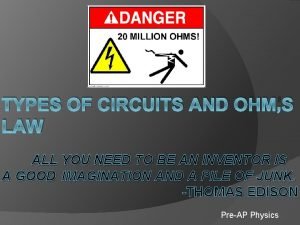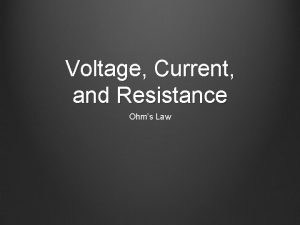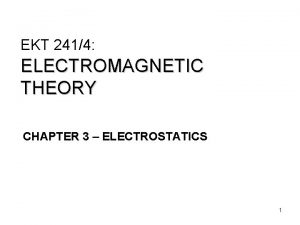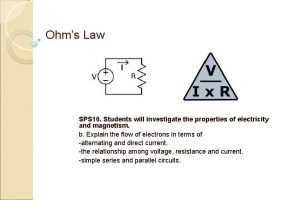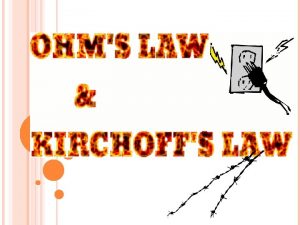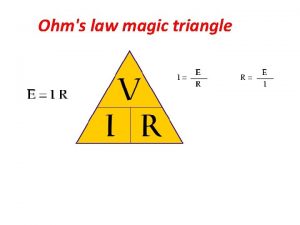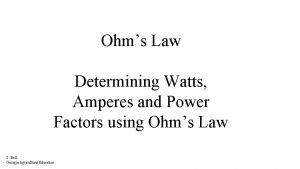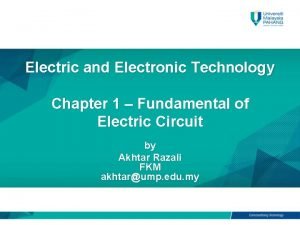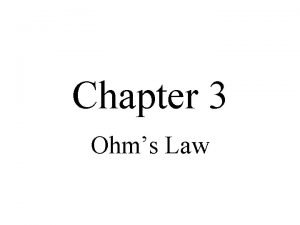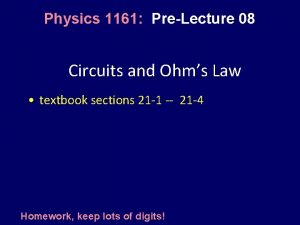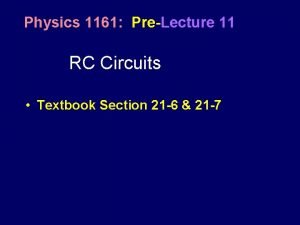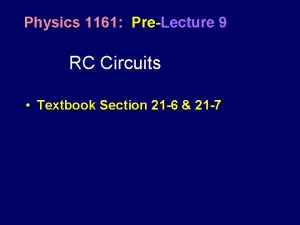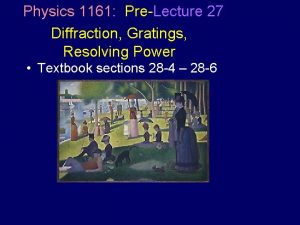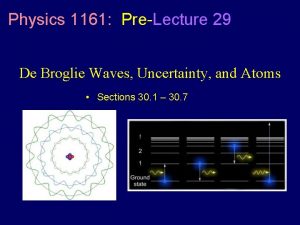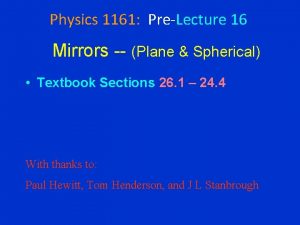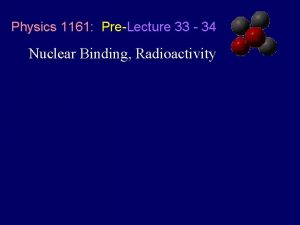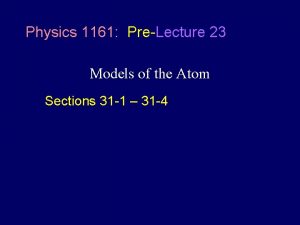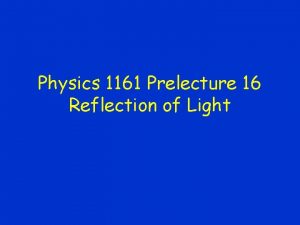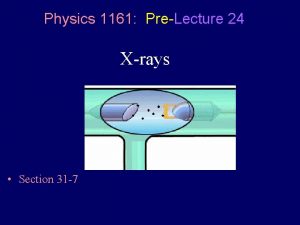Physics 1161 PreLecture 06 Circuits and Ohms Law












- Slides: 12

Physics 1161: Pre-Lecture 06 Circuits and Ohm’s Law • textbook sections 21 -1 -- 21 -4 Homework, keep lots of digits!

Last Time • Capacitors – Physical – Series – Parallel – Energy • Resistors – Physical – Series – Parallel – Power C = e 0 A/d 1/Ceq = 1/C 1 + 1/C 2 Ceq = C 1 + C 2 U = 1/2 QV This One R = r L/A Req = R 1 + R 2 1/Req = 1/R 1 + 1/R 2 P = IV

Electric Terminology • Current: Moving Charges – Symbol: I – Unit: Amp Coulomb/second – Count number of charges which pass point/sec • Power: Energy/Time – Symbol: P – Unit: Watt Joule/second = Volt Coulomb/sec – P = IV

Physical Resistor • Resistance: Traveling through a resistor, electrons bump into things which slows them down. R = r L /A – r: resistivity; constant that depends on the material (i. e. copper, silver, aluminum, etc. ) – L: length of the wire – A: cross sectional area of the wire L • Ohms Law I = V/R – Double potential difference double current A

Resistivity: Material Resistivity at 20°C Ω·m µΩ·cm silver 1. 6 × 10 -8 1. 6 copper 1. 7 × 10 -8 1. 7 gold 2. 2 × 10 -8 2. 2 aluminium 2. 7 × 10 -8 2. 7 magnesium 4. 2 × 10 -8 4. 2 tungsten 5. 4 × 10 -8 5. 4 nickel 6. 9 × 10 -8 6. 9 iron 10. 1 × 10 -8 10. 1

Comparison: Capacitors vs. Resistors • Capacitors store energy as separated charge: U=1/2 QV – Capacitance: ability to store separated charge: C = ke 0 A/d – Voltage determines charge: V=Q/C • Resistors dissipate energy as power: P=VI – Resistance: how difficult it is for charges to get through: R = r L /A – Voltage determines current: V=IR • Don’t mix capacitor and resistor equations!

Resistors in Series • One wire: – Effectively adding lengths: R – Since R L, add resistance: Req = R 1 + R 2 = R 2 R

Resistors in Series • Resistors connected end-to-end: – If current goes through one resistor, it must go through other. I 1 = I 2 = Ieq – Both have voltage drops: V 1 + V 2 = Veq R 1 Req R 2

Resistors in Parallel • Two wires: – Effectively adding the Area – Since R a 1/A add 1/R: R R = R/2

Resistors in Parallel • Both ends of resistor are connected: – Current is split between two wires: I 1 + I 2 = Ieq – Voltage is same across each: V 1 = V 2 = Veq R 1 R 2 Req

Summary Series Parallel R 1 R 2 Wiring Each resistor on the same wire. Each resistor on a different wire. Voltage Different for each resistor. Vtotal = V 1 + V 2 Same for each resistor. Vtotal = V 1 = V 2 Current Same for each resistor Itotal = I 1 = I 2 Different for each resistor Itotal = I 1 + I 2 Increases Req = R 1 + R 2 Decreases 1/Req = 1/R 1 + 1/R 2 Resistance

Parallel + Series Tests • Resistors R 1 and R 2 are in series if and only if every loop that contains R 1 also contains R 2 • Resistors R 1 and R 2 are in parallel if and only if you can make a loop that has ONLY R 1 and R 2 • Same rules apply to capacitors!!
 Types of circuits and ohm's law
Types of circuits and ohm's law Current in a parallel circuit
Current in a parallel circuit Https //phet.colorado.edu/en/simulation/ohms-law
Https //phet.colorado.edu/en/simulation/ohms-law Point form of ohms law
Point form of ohms law Ohms law resistance
Ohms law resistance State ohm's law
State ohm's law Triangle ohms law
Triangle ohms law Ohm's law watts
Ohm's law watts Ohms law emf
Ohms law emf Kirchoffs current law
Kirchoffs current law Ohm's law introduction
Ohm's law introduction Chapter 35 electric circuits answers
Chapter 35 electric circuits answers A certain light bulb
A certain light bulb
